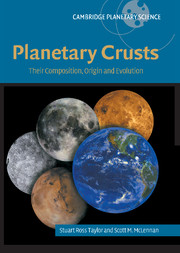Book contents
- Frontmatter
- Contents
- Preface
- Acknowledgments
- List of abbreviations
- Prologue
- 1 The planets: their formation and differentiation
- 2 A primary crust: the highland crust of the Moon
- 3 A secondary crust: the lunar maria
- 4 Mercury
- 5 Mars: early differentiation and planetary composition
- 6 Mars: crustal composition and evolution
- 7 Venus: a twin planet to Earth?
- 8 The oceanic crust of the Earth
- 9 The Hadean crust of the Earth
- 10 The Archean crust of the Earth
- 11 The Post-Archean continental crust
- 12 Composition and evolution of the continental crust
- 13 Crusts on minor bodies
- 14 Reflections: the elusive patterns of planetary crusts
- Indexes
- References
12 - Composition and evolution of the continental crust
Published online by Cambridge University Press: 22 October 2009
- Frontmatter
- Contents
- Preface
- Acknowledgments
- List of abbreviations
- Prologue
- 1 The planets: their formation and differentiation
- 2 A primary crust: the highland crust of the Moon
- 3 A secondary crust: the lunar maria
- 4 Mercury
- 5 Mars: early differentiation and planetary composition
- 6 Mars: crustal composition and evolution
- 7 Venus: a twin planet to Earth?
- 8 The oceanic crust of the Earth
- 9 The Hadean crust of the Earth
- 10 The Archean crust of the Earth
- 11 The Post-Archean continental crust
- 12 Composition and evolution of the continental crust
- 13 Crusts on minor bodies
- 14 Reflections: the elusive patterns of planetary crusts
- Indexes
- References
Summary
It is difficult to calculate what the composition of the crust of the Earth is in any reliable way
(Harold Urey)The composition of the upper part of the continental crust is well established, but it is so enriched in incompatible elements and the heat-producing elements K, U and Th in particular, that it cannot be representative of the entire crust. Unfortunately the inaccessible and largely unknown nature of the lower continental crust makes it more difficult to determine the overall crustal composition so that elements of model-dependency enter the discussion. Because the crust is a significant reservoir for many elements, understanding its overall chemical composition is of fundamental importance to geochemistry as these data place constraints on the basic processes of crustal growth, differentiation and evolution of the mantle.
Because of these restrictions, indirect evidence from the geophysical disciplines (e.g. heat flow, seismology) has to be employed mostly to obtain the bulk composition of the continental crust. So in contrast to upper crustal abundances where there is a consensus, the chemical composition of the bulk crust is much more controversial, with recent models covering a broad range from basalt through to dacite (Fig. 12.1).
However, compositions at both extremes encounter a variety of problems that are difficult to reconcile with known crustal characteristics. In our opinion, the combination of constraints imposed by the upper crustal composition, heat flow and geochemistry yields reliable compositions for the bulk crust.
- Type
- Chapter
- Information
- Planetary CrustsTheir Composition, Origin and Evolution, pp. 301 - 324Publisher: Cambridge University PressPrint publication year: 2008
References
- 3
- Cited by

